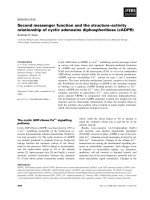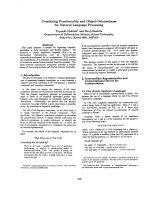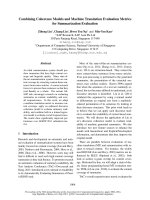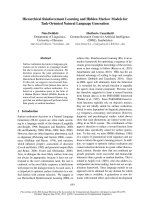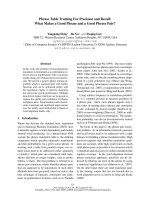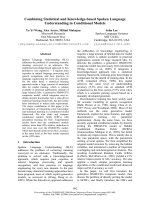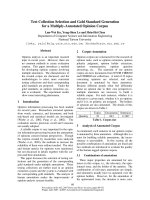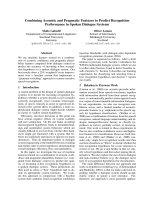Báo cáo khoa học: "Combining EM Training and the MDL Principle for an Automatic Verb Classification incorporating Selectional Preferences" pot
Bạn đang xem bản rút gọn của tài liệu. Xem và tải ngay bản đầy đủ của tài liệu tại đây (197.03 KB, 9 trang )
Proceedings of ACL-08: HLT, pages 496–504,
Columbus, Ohio, USA, June 2008.
c
2008 Association for Computational Linguistics
Combining EM Training and the MDL Principle for an
Automatic Verb Classification incorporating Selectional Preferences
Sabine Schulte im Walde, Christian Hying, Christian Scheible, Helmut Schmid
Institute for Natural Language Processing
University of Stuttgart, Germany
{schulte,hyingcn,scheibcn,schmid}@ims.uni-stuttgart.de
Abstract
This paper presents an innovative, complex
approach to semantic verb classification that
relies on selectional preferences as verb prop-
erties. The probabilistic verb class model un-
derlying the semantic classes is trained by
a combination of the EM algorithm and the
MDL principle, providing soft clusters with
two dimensions (verb senses and subcategori-
sation frames with selectional preferences) as
a result. A language-model-based evaluation
shows that after 10 training iterations the verb
class model results are above the baseline re-
sults.
1 Introduction
In recent years, the computational linguistics com-
munity has developed an impressive number of se-
mantic verb classifications, i.e., classifications that
generalise over verbs according to their semantic
properties. Intuitive examples of such classifica-
tions are the MOTION WITH A VEHICLE class, in-
cluding verbs such as drive, fly, row, etc., or the
BREAK A SOLID SURFACE WITH AN INSTRUMENT
class, including verbs such as break, crush, frac-
ture, smash, etc. Semantic verb classifications are
of great interest to computational linguistics, specifi-
cally regarding the pervasive problem of data sparse-
ness in the processing of natural language. Up to
now, such classifications have been used in applica-
tions such as word sense disambiguation (Dorr and
Jones, 1996; Kohomban and Lee, 2005), machine
translation (Prescher et al., 2000; Koehn and Hoang,
2007), document classification (Klavans and Kan,
1998), and in statistical lexical acquisition in gen-
eral (Rooth et al., 1999; Merlo and Stevenson, 2001;
Korhonen, 2002; Schulte im Walde, 2006).
Given that the creation of semantic verb classi-
fications is not an end task in itself, but depends
on the application scenario of the classification, we
find various approaches to an automatic induction of
semantic verb classifications. For example, Siegel
and McKeown (2000) used several machine learn-
ing algorithms to perform an automatic aspectual
classification of English verbs into event and sta-
tive verbs. Merlo and Stevenson (2001) presented
an automatic classification of three types of English
intransitive verbs, based on argument structure and
heuristics to thematic relations. Pereira et al. (1993)
and Rooth et al. (1999) relied on the Expectation-
Maximisation algorithm to induce soft clusters of
verbs, based on the verbs’ direct object nouns. Sim-
ilarly, Korhonen et al. (2003) relied on the Informa-
tion Bottleneck (Tishby et al., 1999) and subcate-
gorisation frame types to induce soft verb clusters.
This paper presents an innovative, complex ap-
proach to semantic verb classes that relies on se-
lectional preferences as verb properties. The un-
derlying linguistic assumption for this verb class
model is that verbs which agree on their selec-
tional preferences belong to a common seman-
tic class. The model is implemented as a soft-
clustering approach, in order to capture the poly-
semy of the verbs. The training procedure uses the
Expectation-Maximisation (EM) algorithm (Baum,
1972) to iteratively improve the probabilistic param-
eters of the model, and applies the Minimum De-
scription Length (MDL) principle (Rissanen, 1978)
to induce WordNet-based selectional preferences for
arguments within subcategorisation frames. Our
model is potentially useful for lexical induction
(e.g., verb senses, subcategorisation and selectional
preferences, collocations, and verb alternations),
496
and for NLP applications in sparse data situations.
In this paper, we provide an evaluation based on a
language model.
The remainder of the paper is organised as fol-
lows. Section 2 introduces our probabilistic verb
class model, the EM training, and how we incor-
porate the MDL principle. Section 3 describes the
clustering experiments, including the experimental
setup, the evaluation, and the results. Section 4 re-
ports on related work, before we close with a sum-
mary and outlook in Section 5.
2 Verb Class Model
2.1 Probabilistic Model
This paper suggests a probabilistic model of verb
classes that groups verbs into clusters with simi-
lar subcategorisation frames and selectional prefer-
ences. Verbs may be assigned to several clusters
(soft clustering) which allows the model to describe
the subcategorisation properties of several verb read-
ings separately. The number of clusters is defined
in advance, but the assignment of the verbs to the
clusters is learnt during training. It is assumed that
all verb readings belonging to one cluster have simi-
lar subcategorisation and selectional properties. The
selectional preferences are expressed in terms of se-
mantic concepts from WordNet, rather than a set of
individual words. Finally, the model assumes that
the different arguments are mutually independent for
all subcategorisation frames of a cluster. From the
last assumption, it follows that any statistical depen-
dency between the arguments of a verb has to be ex-
plained by multiple readings.
The statistical model is characterised by the fol-
lowing equation which defines the probability of a
verb v with a subcategorisation frame f and argu-
ments a
1
, , a
n
f
:
p(v, f, a
1
, , a
n
f
) =
c
p(c) p(v|c) p(f|c) ∗
n
f
i=1
r∈R
p(r|c, f, i) p(a
i
|r)
The model describes a stochastic process which gen-
erates a verb-argument tuple like speak, subj-pp.to,
professor, audience by
1. selecting some cluster c, e.g. c
3
(which might
correspond to a set of communication verbs),
with probability p(c
3
),
2. selecting a verb v, here the verb speak, from
cluster c
3
with probability p(speak|c
3
),
3. selecting a subcategorisation frame f, here
subj-pp.to, with probability p(subj-pp.to|c
3
);
note that the frame probability only depends on
the cluster, and not on the verb,
4. selecting a WordNet concept r for each argu-
ment slot, e.g. person for the first slot with
probability p(person|c
3
, subj-pp.to, 1) and so-
cial group for the second slot with probability
p(social group|c
3
, subj-pp.to, 2),
5. selecting a word a
i
to instantiate each con-
cept as argument i; in our example, we
might choose professor for person with
probability p(professor|person) and au-
dience for social group with probability
p(audience|social group).
The model contains two hidden variables, namely
the clusters c and the selectional preferences r. In or-
der to obtain the overall probability of a given verb-
argument tuple, we have to sum over all possible val-
ues of these hidden variables.
The assumption that the arguments are indepen-
dent of the verb given the cluster is essential for ob-
taining a clustering algorithm because it forces the
EM algorithm to make the verbs within a cluster as
similar as possible.
1
The assumption that the differ-
ent arguments of a verb are mutually independent is
important to reduce the parameter set to a tractable
size
The fact that verbs select for concepts rather than
individual words also reduces the number of param-
eters and helps to avoid sparse data problems. The
application of the MDL principle guarantees that no
important information is lost.
The probabilities p(r|c, f, i) and p(a|r) men-
tioned above are not represented as atomic enti-
ties. Instead, we follow an approach by Abney
1
The EM algorithm adjusts the model parameters in such a
way that the probability assigned to the training tuples is max-
imised. Given the model constraints, the data probability can
only be maximised by making the verbs within a cluster as sim-
ilar to each other as possible, regarding the required arguments.
497
and Light (1999) and turn WordNet into a Hidden
Markov model (HMM). We create a new pseudo-
concept for each WordNet noun and add it as a hy-
ponym to each synset containing this word. In ad-
dition, we assign a probability to each hypernymy–
hyponymy transition, such that the probabilities of
the hyponymy links of a synset sum up to 1. The
pseudo-concept nodes emit the respective word with
a probability of 1, whereas the regular concept nodes
are non-emitting nodes. The probability of a path
in this (a priori) WordNet HMM is the product of
the probabilities of the transitions within the path.
The probability p(a|r) is then defined as the sum
of the probabilities of all paths from the concept r
to the word a. Similarly, we create a partial Word-
Net HMM for each argument slot c, f, i which en-
codes the selectional preferences. It contains only
the WordNet concepts that the slot selects for, ac-
cording to the MDL principle (cf. Section 2.3), and
the dominating concepts. The probability p(r|c, f, i)
is the total probability of all paths from the top-most
WordNet concept entity to the terminal node r.
2.2 EM Training
The model is trained on verb-argument tuples of
the form described above, i.e., consisting of a verb
and a subcategorisation frame, plus the nominal
2
heads of the arguments. The tuples may be ex-
tracted from parsed data, or from a treebank. Be-
cause of the hidden variables, the model is trained
iteratively with the Expectation-Maximisation algo-
rithm (Baum, 1972). The parameters are randomly
initialised and then re-estimated with the Inside-
Outside algorithm (Lari and Young, 1990) which is
an instance of the EM algorithm for training Proba-
bilistic Context-Free Grammars (PCFGs).
The PCFG training algorithm is applicable here
because we can define a PCFG for each of our mod-
els which generates the same verb-argument tuples
with the same probability. The PCFG is defined as
follows:
(1) The start symbol is TOP.
(2) For each cluster c, we add a rule TOP → V
c
A
c
whose probability is p(c).
2
Arguments with lexical heads other than nouns (e.g., sub-
categorised clauses) are not included in the selectional prefer-
ence induction.
(3) For each verb v in cluster c, we add a rule
V
c
→ v with probability p(v|c).
(4) For each subcategorisation frame f of cluster c
with length n, we add a rule A
c
→ f R
c,f,1,entity
R
c,f,n,entity
with probability p(f |c).
(5) For each transition from a node r to a node r
′
in the selectional preference model for slot i of
the subcategorisation frame f of cluster c, we
add a rule R
c,f,i,r
→ R
c,f,i,r
′
whose probability
is the transition probability from r to r
′
in the
respective WordNet-HMM.
(6) For each terminal node r in the selectional pref-
erence model, we add a rule R
c,f,i,r
→ R
r
whose
probability is 1. With this rule, we “jump” from
the selectional restriction model to the corre-
sponding node in the a priori model.
(7) For each transition from a node r to a node r
′
in the a priori model, we add a rule R
r
→ R
r
′
whose probability is the transition probability
from r to r
′
in the a priori WordNet-HMM.
(8) For each word node a in the a priori model, we
add a rule R
a
→ a whose probability is 1.
Based on the above definitions, a partial “parse” for
speak subj-pp.to professor audience, referring to
cluster 3 and one possible WordNet path, is shown in
Figure 1. The connections within R
3
(R
3, ,entity
–
R
3, ,person/group
) and within R (R
person/group
–
R
professor/audience
) refer to sequential applications
of rule types (5) and (7), respectively.
TOP
V
3
speak
A
3
subj-pp.to R
3,subj−pp.to,1,entity
R
3,subj−pp.to,1,person
R
person
R
prof essor
professor
R
3,subj−pp.to,2,entity
R
3,subj−pp.to,2,group
R
group
R
audience
audience
Figure 1: Example parse tree.
The EM training algorithm maximises the likelihood
of the training data.
498
2.3 MDL Principle
A model with a large number of fine-grained con-
cepts as selectional preferences assigns a higher
likelihood to the data than a model with a small num-
ber of general concepts, because in general a larger
number of parameters is better in describing train-
ing data. Consequently, the EM algorithm a pri-
ori prefers fine-grained concepts but – due to sparse
data problems – tends to overfit the training data. In
order to find selectional preferences with an appro-
priate granularity, we apply the Minimum Descrip-
tion Length principle, an approach from Information
Theory. According to the MDL principle, the model
with minimal description length should be chosen.
The description length itself is the sum of the model
length and the data length, with the model length
defined as the number of bits needed to encode the
model and its parameters, and the data length de-
fined as the number of bits required to encode the
training data with the given model. According to
coding theory, an optimal encoding uses −log
2
p
bits, on average, to encode data whose probability
is p. Usually, the model length increases and the
data length decreases as more parameters are added
to a model. The MDL principle finds a compromise
between the size of the model and the accuracy of
the data description.
Our selectional preference model relies on Li and
Abe (1998), applying the MDL principle to deter-
mine selectional preferences of verbs and their argu-
ments, by means of a concept hierarchy ordered by
hypernym/hyponym relations. Given a set of nouns
within a specific argument slot as a sample, the ap-
proach finds the cut
3
in a concept hierarchy which
minimises the sum of encoding both the model and
the data. The model length (ML) is defined as
ML =
k
2
∗ log
2
|S|,
with k the number of concepts in the partial hierar-
chy between the top concept and the concepts in the
cut, and |S| the sample size, i.e., the total frequency
of the data set. The data length (DL) is defined as
DL = −
n∈S
log
2
p(n).
3
A cut is defined as a set of concepts in the concept hier-
archy that defines a partition of the ”leaf” concepts (the lowest
concepts in the hierarchy), viewing each concept in the cut as
representing the set of all leaf concepts it dominates.
The probability of a noun p(n) is determined by di-
viding the total probability of the concept class the
noun belongs to, p(concept), by the size of that
class, |concept|, i.e., the number of nouns that are
dominated by that concept:
p(n) =
p(concept)
|concept|
.
The higher the concept within the hierarchy, the
more nouns receive an equal probability, and the
greater is the data length.
The probability of the concept class in turn is de-
termined by dividing the frequency of the concept
class f(concept) by the sample size:
p(concept) =
f (concept)
|S|
,
where f(concept) is calculated by upward propaga-
tion of the frequencies of the nominal lexemes from
the data sample through the hierarchy. For exam-
ple, if the nouns coffee, tea, milk appeared with fre-
quencies 25, 50, 3, respectively, within a specific ar-
gument slot, then their hypernym concept beverage
would be assigned a frequency of 78, and these 78
would be propagated further upwards to the next hy-
pernyms, etc. As a result, each concept class is as-
signed a fraction of the frequency of the whole data
set (and the top concept receives the total frequency
of the data set). For calculating p(concept) (and the
overall data length), though, only the concept classes
within the cut through the hierarchy are relevant.
Our model uses WordNet 3.0 as the concept hier-
archy, and comprises one (complete) a priori Word-
Net model for the lexical head probabilities p(a|r)
and one (partial) model for each selectional proba-
bility distribution p(r|c, f, i), cf. Section 2.1.
2.4 Combining EM and MDL
The training procedure that combines the EM train-
ing with the MDL principle can be summarised as
follows.
1. The probabilities of a verb class model with c
classes and a pre-defined set of verbs and frames
are initialised randomly. The selectional preference
models start out with the most general WordNet con-
cept only, i.e., the partial WordNet hierarchies un-
derlying the probabilities p(r|c, f, i) initially only
contain the concept r for entity.
499
2. The model is trained for a pre-defined num-
ber of iterations. In each iteration, not only the
model probabilities are re-estimated and maximised
(as done by EM), but also the cuts through the con-
cept hierarchies that represent the various selectional
preference models are re-assessed. In each iteration,
the following steps are performed.
(a) The partial WordNet hierarchies that represent
the selectional preference models are expanded to
include the hyponyms of the respective leaf con-
cepts of the partial hierarchies. I.e., in the first itera-
tion, all models are expanded towards the hyponyms
of entity, and in subsequent iterations each selec-
tional preference model is expanded to include the
hyponyms of the leaf nodes in the partial hierarchies
resulting from the previous iteration. This expansion
step allows the selection models to become more and
more detailed, as the training proceeds and the verb
clusters (and their selectional restrictions) become
increasingly specific.
(b) The training tuples are processed: For each tu-
ple, a PCFG parse forest as indicated by Figure 1
is done, and the Inside-Outside algorithm is applied
to estimate the frequencies of the ”parse tree rules”,
given the current model probabilities.
(c) The MDL principle is applied to each selectional
preference model: Starting from the respective leaf
concepts in the partial hierarchies, MDL is calcu-
lated to compare each set of hyponym concepts that
share a hypernym with the respective hypernym con-
cept. If the MDL is lower for the set of hyponyms
than the hypernym, the hyponyms are left in the par-
tial hierarchy. Otherwise the expansion of the hyper-
nym towards the hyponyms is undone and we con-
tinue recursively upwards the hierarchy, calculating
MDL to compare the former hypernym and its co-
hyponyms with the next upper hypernym, etc. The
recursion allows the training algorithm to remove
nodes which were added in earlier iterations and are
no longer relevant. It stops if the MDL is lower for
the hyponyms than for the hypernym.
This step results in selectional preference models
that minimally contain the top concept entity, and
maximally contain the partial WordNet hierarchy
between entity and the concept classes that have
been expanded within this iteration.
(d) The probabilities of the verb class model are
maximised based on the frequency estimates ob-
tained in step (b).
3 Experiments
The model is generally applicable to all languages
for which WordNet exists, and for which the Word-
Net functions provided by Princeton University are
available. For the purposes of this paper, we choose
English as a case study.
3.1 Experimental Setup
The input data for training the verb class mod-
els were derived from Viterbi parses of the whole
British National Corpus, using the lexicalised PCFG
for English by Carroll and Rooth (1998). We took
only active clauses into account, and disregarded
auxiliary and modal verbs as well as particle verbs,
leaving a total of 4,852,371 Viterbi parses. Those in-
put tuples were then divided into 90% training data
and 10% test data, providing 4,367,130 training tu-
ples (over 2,769,804 types), and 485,241 test tuples
(over 368,103 types).
As we wanted to train and assess our verb class
model under various conditions, we used different
fractions of the training data in different training
regimes. Because of time and memory constraints,
we only used training tuples that appeared at least
twice. (For the sake of comparison, we also trained
one model on all tuples.) Furthermore, we dis-
regarded tuples with personal pronoun arguments;
they are not represented in WordNet, and even if
they are added (e.g. to general concepts such as
person, entity) they have a rather destructive ef-
fect. We considered two subsets of the subcate-
gorisation frames with 10 and 20 elements, which
were chosen according to their overall frequency in
the training data; for example, the 10 most frequent
frame types were subj:obj, subj, subj:ap, subj:to,
subj:obj:obj2, subj:obj:pp-in, subj:adv, subj:pp-in,
subj:vbase, subj:that.
4
When relying on theses
10/20 subcategorisation frames, plus including the
above restrictions, we were left with 39,773/158,134
and 42,826/166,303 training tuple types/tokens, re-
spectively. The overall number of training tuples
4
A frame lists its arguments, separated by ’:’. Most argu-
ments within the frame types should be self-explanatory. ap is
an adjectival phrase.
500
was therefore much smaller than the generally avail-
able data. The corresponding numbers including tu-
ples with a frequency of one were 478,717/597,078
and 577,755/701,232.
The number of clusters in the experiments was ei-
ther 20 or 50, and we used up to 50 iterations over
the training tuples. The model probabilities were
output after each 5th iteration. The output comprises
all model probabilities introduced in Section 2.1.
The following sections describe the evaluation of the
experiments, and the results.
3.2 Evaluation
One of the goals in the development of the presented
verb class model was to obtain an accurate statistical
model of verb-argument tuples, i.e. a model which
precisely predicts the tuple probabilities. In order
to evaluate the performance of the model in this re-
spect, we conducted an evaluation experiment, in
which we computed the probability which the verb
class model assigns to our test tuples and compared
it to the corresponding probability assigned by a
baseline model. The model with the higher proba-
bility is judged the better model.
We expected that the verb class model would
perform better than the baseline model on tuples
where one or more of the arguments were not ob-
served with the respective verb, because either the
argument itself or a semantically similar argument
(according to the selectional preferences) was ob-
served with verbs belonging to the same cluster. We
also expected that the verb class model assigns a
lower probability than the baseline model to test tu-
ples which frequently occurred in the training data,
since the verb class model fails to describe precisely
the idiosyncratic properties of verbs which are not
shared by the other verbs of its cluster.
The Baseline Model The baseline model decom-
poses the probability of a verb-argument tuple into a
product of conditional probabilities:
5
p(v, f, a
n
f
1
) = p(v) p(f|v)
n
f
i=1
p(a
i
|a
i−1
1
, v, f, f
i
)
5
f
i
is the label of the i
th
slot. The verb and the subcategori-
sation frame are enclosed in angle brackets because they are
treated as a unit during smoothing.
The probability of our example tuple speak,
subj-pp.to, professor, audience in the base-
line model is then p(speak) p(subj-pp.to|speak)
p(professor|speak, subj-pp.to, subj) p(audience|
professor, speak, subj-pp.to, pp.to).
The model contains no hidden variables. Thus the
parameters can be directly estimated from the train-
ing data with relative frequencies. The parameter
estimates are smoothed with modified Kneser-Ney
smoothing (Chen and Goodman, 1998), such that
the probability of each tuple is positive.
Smoothing of the Verb Class Model Although
the verb class model has a built-in smoothing capac-
ity, it needs additional smoothing for two reasons:
Firstly, some of the nouns in the test data did not
occur in the training data. The verb class model
assigns a zero probability to such nouns. Hence
we smoothed the concept instantiation probabilities
p(noun|concept) with Witten-Bell smoothing (Chen
and Goodman, 1998). Secondly, we smoothed the
probabilities of the concepts in the selectional pref-
erence models where zero probabilities may occur.
The smoothing ensures that the verb class model
assigns a positive probability to each verb-argument
tuple with a known verb, a known subcategorisation
frame, and arguments which are in WordNet. Other
tuples were excluded from the evaluation because
the verb class model cannot deal with them.
3.3 Results
The evaluation results of our classification experi-
ments are presented in Table 1, for 20 and 50 clus-
ters, with 10 and 20 subcategorisation frame types.
The table cells provide the log
e
of the probabilities
per tuple token. The probabilities increase with the
number of iterations, flattening out after approx. 25
iterations, as illustrated by Figure 2. Both for 10
and 20 frames, the results are better for 50 than for
20 clusters, with small differences between 10 and
20 frames. The results vary between -11.850 and
-10.620 (for 5-50 iterations), in comparison to base-
line values of -11.546 and -11.770 for 10 and 20
frames, respectively. The results thus show that our
verb class model results are above the baseline re-
sults after 10 iterations; this means that our statis-
tical model then assigns higher probabilities to the
test tuples than the baseline model.
501
No. of Iteration
Clusters 5 10 15 20 25 30 35 40 45 50
10 frames
20 -11.770 -11.408 -10.978 -10.900 -10.853 -10.841 -10.831 -10.823 -10.817 -10.812
50 -11.850 -11.452 -11.061 -10.904 -10.730 -10.690 -10.668 -10.628 -10.625 -10.620
20 frames
20 -11.769 -11.430 -11.186 -10.971 -10.921 -10.899 -10.886 -10.875 -10.873 -10.869
50 -11.841 -11.472 -11.018 -10.850 -10.737 -10.728 -10.706 -10.680 -10.662 -10.648
Table 1: Clustering results – BNC tuples.
Figure 2: Illustration of clustering results.
Including input tuples with a frequency of one in
the training data with 10 subcategorisation frames
(as mentioned in Section 3.1) decreases the log
e
per
tuple to between -13.151 and -12.498 (for 5-50 it-
erations), with similar training behaviour as in Fig-
ure 2, and in comparsion to a baseline of -17.988.
The differences in the result indicate that the mod-
els including the hapax legomena are worse than the
models that excluded the sparse events; at the same
time, the differences between baseline and cluster-
ing model are larger.
In order to get an intuition about the qualitative
results of the clusterings, we select two example
clusters that illustrate that the idea of the verb class
model has been realised within the clusters. Ac-
cording to our own intuition, the clusters are over-
all semantically impressive, beyond the examples.
Future work will assess by semantics-based eval-
uations of the clusters (such as pseudo-word dis-
ambiguation, or a comparison against existing verb
classifications), whether this intuition is justified,
whether it transfers to the majority of verbs within
the cluster analyses, and whether the clusters cap-
ture polysemic verbs appropriately.
The two examples are taken from the 10 frame/50
cluster verb class model, with probabilities of 0.05
and 0.04. The ten most probable verbs in the first
cluster are show, suggest, indicate, reveal, find, im-
ply, conclude, demonstrate, state, mean, with the
two most probable frame types subj and subj:that,
i.e., the intransitive frame, and a frame that subcat-
egorises a that clause. As selectional preferences
within the intransitive frame (and quite similarly
in the subj:that frame), the most probable concept
classes
6
are study, report
, survey, name, research,
result
, evidence. The underlined nouns represent
specific concept classes, because they are leaf nodes
in the selectional preference hierarchy, thus refer-
ring to very specific selectional preferences, which
are potentially useful for collocation induction. The
ten most probable verbs in the second cluster are
arise, remain, exist, continue, need, occur, change,
improve, begin, become, with the intransitive frame
being most probable. The most probable concept
classes are problem
, condition, question, natural
phenomenon, situation
. The two examples illustrate
that the verbs within a cluster are semantically re-
lated, and that they share obvious subcategorisation
frames with intuitively plausible selectional prefer-
ences.
4 Related Work
Our model is an extension of and thus most closely
related to the latent semantic clustering (LSC) model
(Rooth et al., 1999) for verb-argument pairs v, a
which defines their probability as follows:
p(v, a) =
c
p(c) p(v|c) p(a|c)
In comparison to our model, the LSC model only
considers a single argument (such as direct objects),
6
For readability, we only list one noun per WordNet concept.
502
or a fixed number of arguments from one particu-
lar subcategorisation frame, whereas our model de-
fines a probability distribution over all subcategori-
sation frames. Furthermore, our model specifies se-
lectional preferences in terms of general WordNet
concepts rather than sets of individual words.
In a similar vein, our model is both similar and
distinct in comparison to the soft clustering ap-
proaches by Pereira et al. (1993) and Korhonen et
al. (2003). Pereira et al. (1993) suggested determin-
istic annealing to cluster verb-argument pairs into
classes of verbs and nouns. On the one hand, their
model is asymmetric, thus not giving the same in-
terpretation power to verbs and arguments; on the
other hand, the model provides a more fine-grained
clustering for nouns, in the form of an additional hi-
erarchical structure of the noun clusters. Korhonen
et al. (2003) used verb-frame pairs (instead of verb-
argument pairs) to cluster verbs relying on the Infor-
mation Bottleneck (Tishby et al., 1999). They had
a focus on the interpretation of verbal polysemy as
represented by the soft clusters. The main difference
of our model in comparison to the above two models
is, again, that we incorporate selectional preferences
(rather than individual words, or subcategorisation
frames).
In addition to the above soft-clustering models,
various approaches towards semantic verb classifi-
cation have relied on hard-clustering models, thus
simplifying the notion of verbal polysemy. Two
large-scale approaches of this kind are Schulte im
Walde (2006), who used k-Means on verb subcat-
egorisation frames and verbal arguments to cluster
verbs semantically, and Joanis et al. (2008), who ap-
plied Support Vector Machines to a variety of verb
features, including subcategorisation slots, tense,
voice, and an approximation to animacy. To the
best of our knowledge, Schulte im Walde (2006) is
the only hard-clustering approach that previously in-
corporated selectional preferences as verb features.
However, her model was not soft-clustering, and
she only used a simple approach to represent selec-
tional preferences by WordNet’s top-level concepts,
instead of making use of the whole hierarchy and
more sophisticated methods, as in the current paper.
Last but not least, there are other models of se-
lectional preferences than the MDL model we used
in our paper. Most such models also rely on the
WordNet hierarchy (Resnik, 1997; Abney and Light,
1999; Ciaramita and Johnson, 2000; Clark and Weir,
2002). Brockmann and Lapata (2003) compared
some of the models against human judgements on
the acceptability of sentences, and demonstrated that
the models were significantly correlated with human
ratings, and that no model performed best; rather,
the different methods are suited for different argu-
ment relations.
5 Summary and Outlook
This paper presented an innovative, complex ap-
proach to semantic verb classes that relies on se-
lectional preferences as verb properties. The prob-
abilistic verb class model underlying the semantic
classes was trained by a combination of the EM al-
gorithm and the MDL principle, providing soft clus-
ters with two dimensions (verb senses and subcate-
gorisation frames with selectional preferences) as a
result. A language model-based evaluation showed
that after 10 training iterations the verb class model
results are above the baseline results.
We plan to improve the verb class model with re-
spect to (i) a concept-wise (instead of a cut-wise)
implementation of the MDL principle, to operate on
concepts instead of combinations of concepts; and
(ii) variations of the concept hierarchy, using e.g. the
sense-clustered WordNets from the Stanford Word-
Net Project (Snow et al., 2007), or a WordNet ver-
sion improved by concepts from DOLCE (Gangemi
et al., 2003), to check on the influence of concep-
tual details on the clustering results. Furthermore,
we aim to use the verb class model in NLP tasks, (i)
as resource for lexical induction of verb senses, verb
alternations, and collocations, and (ii) as a lexical
resource for the statistical disambiguation of parse
trees.
References
Steven Abney and Marc Light. 1999. Hiding a Seman-
tic Class Hierarchy in a Markow Model. In Proceed-
ings of the ACL Workshop on Unsupervised Learning
in Natural Language Processing, pages 1–8, College
Park, MD.
Leonard E. Baum. 1972. An Inequality and Associated
Maximization Technique in Statistical Estimation for
Probabilistic Functions of Markov Processes. Inequal-
ities, III:1–8.
503
Carsten Brockmann and Mirella Lapata. 2003. Evaluat-
ing and Combining Approaches to Selectional Prefer-
ence Acquisition. In Proceedings of the 10th Confer-
ence of the European Chapter of the Association for
Computational Linguistics, pages 27–34, Budapest,
Hungary.
Glenn Carroll and Mats Rooth. 1998. Valence Induction
with a Head-Lexicalized PCFG. In Proceedings of the
3rd Conference on Empirical Methods in Natural Lan-
guage Processing, Granada, Spain.
Stanley Chen and Joshua Goodman. 1998. An Empirical
Study of Smoothing Techniques for Language Model-
ing. Technical Report TR-10-98, Center for Research
in Computing Technology, Harvard University.
Massimiliano Ciaramita and Mark Johnson. 2000. Ex-
plaining away Ambiguity: Learning Verb Selectional
Preference with Bayesian Networks. In Proceedings
of the 18th International Conference on Computa-
tional Linguistics, pages 187–193, Saarbr¨ucken, Ger-
many.
Stephen Clark and David Weir. 2002. Class-Based Prob-
ability Estimation using a Semantic Hierarchy. Com-
putational Linguistics, 28(2):187–206.
Bonnie J. Dorr and Doug Jones. 1996. Role of Word
Sense Disambiguation in Lexical Acquisition: Predict-
ing Semantics from Syntactic Cues. In Proceedings of
the 16th International Conference on Computational
Linguistics, pages 322–327, Copenhagen, Denmark.
Aldo Gangemi, Nicola Guarino, Claudio Masolo, and
Alessandro Oltramari. 2003. Sweetening WordNet
with DOLCE. AI Magazine, 24(3):13–24.
Eric Joanis, Suzanne Stevenson, and David James. 2008?
A General Feature Space for Automatic Verb Classifi-
cation. Natural Language Engineering. To appear.
Judith L. Klavans and Min-Yen Kan. 1998. The Role
of Verbs in Document Analysis. In Proceedings of
the 17th International Conference on Computational
Linguistics and the 36th Annual Meeting of the Asso-
ciation for Computational Linguistics, pages 680–686,
Montreal, Canada.
Philipp Koehn and Hieu Hoang. 2007. Factored Trans-
lation Models. In Proceedings of the Joint Conference
on Empirical Methods in Natural Language Process-
ing and Computational Natural Language Learning,
pages 868–876, Prague, Czech Republic.
Upali S. Kohomban and Wee Sun Lee. 2005. Learning
Semantic Classes for Word Sense Disambiguation. In
Proceedings of the 43rd Annual Meeting on Associa-
tion for Computational Linguistics, pages 34–41, Ann
Arbor, MI.
Anna Korhonen, Yuval Krymolowski, and Zvika Marx.
2003. Clustering Polysemic Subcategorization Frame
Distributions Semantically. In Proceedings of the 41st
Annual Meeting of the Association for Computational
Linguistics, pages 64–71, Sapporo, Japan.
Anna Korhonen. 2002. Subcategorization Acquisition.
Ph.D. thesis, University of Cambridge, Computer Lab-
oratory. Technical Report UCAM-CL-TR-530.
Karim Lari and Steve J. Young. 1990. The Estimation of
Stochastic Context-Free Grammars using the Inside-
Outside Algorithm. Computer Speech and Language,
4:35–56.
Hang Li and Naoki Abe. 1998. Generalizing Case
Frames Using a Thesaurus and the MDL Principle.
Computational Linguistics, 24(2):217–244.
Paola Merlo and Suzanne Stevenson. 2001. Automatic
Verb Classification Based on Statistical Distributions
of Argument Structure. Computational Linguistics,
27(3):373–408.
Fernando Pereira, Naftali Tishby, and Lillian Lee. 1993.
Distributional Clustering of English Words. In Pro-
ceedings of the 31st Annual Meeting of the Associ-
ation for Computational Linguistics, pages 183–190,
Columbus, OH.
Detlef Prescher, Stefan Riezler, and Mats Rooth. 2000.
Using a Probabilistic Class-Based Lexicon for Lexical
Ambiguity Resolution. In Proceedings of the 18th In-
ternational Conference on Computational Linguistics.
Philip Resnik. 1997. Selectional Preference and Sense
Disambiguation. In Proceedings of the ACL SIGLEX
Workshop on Tagging Text with Lexical Semantics:
Why, What, and How?, Washington, DC.
Jorma Rissanen. 1978. Modeling by Shortest Data De-
scription. Automatica, 14:465–471.
Mats Rooth, Stefan Riezler, Detlef Prescher, Glenn Car-
roll, and Franz Beil. 1999. Inducing a Semantically
Annotated Lexicon via EM-Based Clustering. In Pro-
ceedings ofthe 37th Annual Meeting of the Association
for Computational Linguistics, Maryland, MD.
Sabine Schulte im Walde. 2006. Experiments on the Au-
tomatic Induction of German Semantic Verb Classes.
Computational Linguistics, 32(2):159–194.
Eric V. Siegel and Kathleen R. McKeown. 2000.
Learning Methods to Combine Linguistic Indica-
tors: Improving Aspectual Classification and Reveal-
ing Linguistic Insights. Computational Linguistics,
26(4):595–628.
Rion Snow, Sushant Prakash, Daniel Jurafsky, and An-
drew Y. Ng. 2007. Learning to Merge Word Senses.
In Proceedings of the joint Conference on Empirical
Methods in Natural Language Processing and Com-
putational Natural Language Learning, Prague, Czech
Republic.
Naftali Tishby, Fernando Pereira, and William Bialek.
1999. The Information Bottleneck Method. In Pro-
ceedings of the 37th Annual Conference on Communi-
cation, Control, and Computing, Monticello, IL.
504

